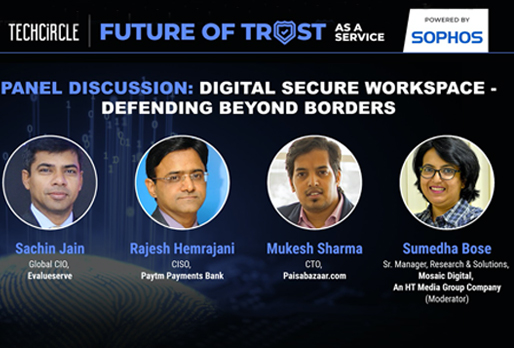While security remains a major concern, users expect a frictionless experience in their corporate digital journey, indifferently using corporate assets or their own devices. Organizations, therefore, need to ensure digital workplace security and the infrastructure in this borderless and cloud world. Employees are no longer limited to the perimeter of their organization. Working from anywhere and with any device, they are using several cloud services and applications every day.
To discuss these critical challenges TechCircle organised a panel discussion in their recently concluded digital conclave Future of Trust As A Service powered by Sophos where industry experts and torchbearers to deliberate on the future of cybersecurity, its implementation, challenges, and solutions, thus carving a roadmap for the future. The panel discussion on Digital Secure Workforce: Defending Beyond Borders comprised of industry veterans like Sachin Jain, Global CIO, Evalueserve, Mukesh Sharma, CTO, Paisabazaar.com and SumedhaBose, Senior Manager, Research & Solutions, Mosaic Digital, an HT Media Group Company who moderated the discussion.
During the discussion, Sachin Jain quoted, "percentage of remote workers have taken a reverse position. We used to have maybe anywhere between five to 10% people working from a remote location, or maybe home offices, before the pandemic. And now, we all we also saw 100% people working from home. But now since our China office is operational, and that is the only office that is operational, and I can probably see around eight to 10% people are working from the office, and most of them are working from home still." In the not too distant past, the idea that an employee would have access to an enterprise’s most sensitive data via a mobile device that the employee purchased and used (not to mention frequently lost) for their private needs was inconceivable. Today, it’s table stakes.
Make your inbox more interesting.
Subscribe to our newsletter."When there are people inside your office, they have their desktops, they have their logistics in place. But when they are working from home, they can access it from their own devices. So we need to somehow make sure they are accessing our services on a trusted device. This was, again, very challenging and the need of an hour for us was not only allowing them to access from their own devices but also made sure like whatever services they are accessing whatever data they are accessing, they can access it seamlessly and securely", quoted Mukesh Sharma. Every organisation needs to ensure that the data in transit and the data at rest are secured enough. The security levels must be directly proportional to the kind of data we're dealing with. He further added, "the security framework, has to be at all level be it is the internal data access be it is the applications exposed outside be it is the data sharing be it is the customers or the employees who are using the data. The small tools or day-to-day tools, like our mails like our chat, or our engagement tools, we have to make sure all those tools are secure. And because there are different protocols, different security measures, so for every system, you need to have specific security measures and you need to implement that because once you have a loophole then your entire system is compromised."
For more details on this discussion and insights on the security landscape, visit futureoftrust.techcircle.in



